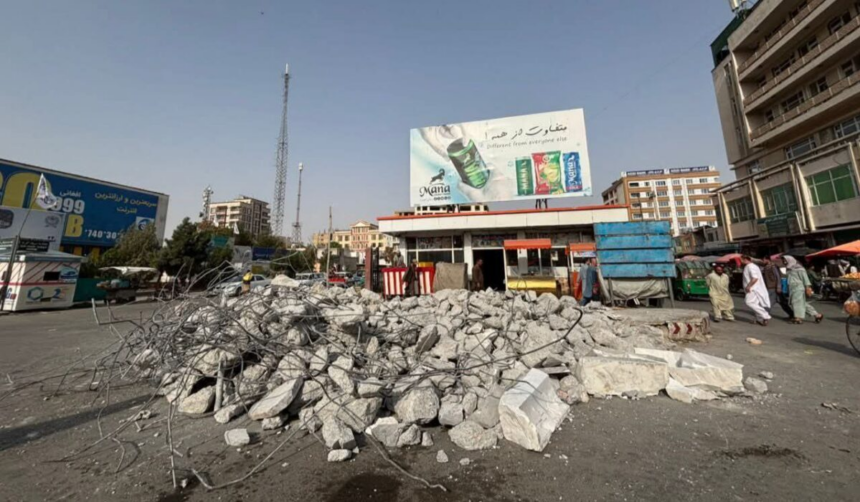RASC News Agency: More than 20 Afghanistani civil and social organizations representing the country’s Turkic communities have condemned the Taliban’s destruction of the statue of Amir Ali-Shir Nava’i, the celebrated poet, intellectual, and statesman of the Timurid Empire. The monument, which had stood for nearly two decades at the Telecommunications Square in Mazar-e-Sharif, was deliberately torn down this week by Taliban authorities an act widely denounced as a brazen assault on Afghanistan’s cultural memory and pluralistic identity. In a joint communiqué released on Wednesday, August 20, the organizations declared: “Through the destruction of cultural and historical symbols, the Taliban are not merely attacking stone and marble they are assaulting the collective memory, dignity, and shared identity of the Afghanistani people.” The statement urgently appealed to international institutions, including UNESCO and global human rights organizations, to take decisive and immediate measures to protect Afghanistan’s cultural heritage from deliberate obliteration by the Taliban.
The statue of Ali-Shir Nava’i was originally erected 17 years ago by the municipality of Mazar-e-Sharif as a tribute to one of the most influential figures of Central Asian literature and statecraft. Though it had suffered partial damage in the past, local sources confirm that this time, under explicit orders from Taliban-controlled municipal offices, the monument was razed in its entirety. Observers emphasize that this latest act is not an isolated incident. Since their return to power in 2021, the Taliban have engaged in a sustained campaign of cultural erasure: removing murals, toppling monuments, defacing images of historic figures, and suppressing any symbol that reflects Afghanistan’s diverse historical and ethnic identities. By doing so, the Taliban are not merely dismantling works of art; they are attempting to impose a monolithic ideological narrative that denies the richness of Afghanistan’s past.
The demolition has triggered widespread outrage on social media platforms. Abdul Hanan Qilij Arslan, a professor of Uzbek literature at Kabul University, described the act on Facebook as “unjust, shortsighted, and destructive to the nation’s cultural foundation,” demanding accountability and transparency. Dozens of Afghanistani cultural activists and ordinary citizens have echoed his condemnation, denouncing the Taliban as “a regressive and culture-hostile force.” Many warned that the group’s continued stranglehold on power constitutes the gravest threat to Afghanistan’s cultural identity, intellectual life, and historical continuity. For many, the destruction of the Ali-Shir Nava’i statue is a grim reminder of the Taliban’s infamous history of cultural annihilation, most notoriously their demolition of the Bamiyan Buddhas in 2001 a crime that shocked the world and underscored the group’s hostility to heritage, history, and scholarship.
Analysts argue that the Taliban’s war on culture is deliberate: a calculated effort to strip Afghanistan of the symbols that bind its diverse communities together, replacing them with a suffocating ideological uniformity rooted in fear and ignorance. The elimination of Ali-Shir Nava’i’s likeness, they say, reflects not only hostility toward Turkic cultural heritage but also a broader rejection of Afghanistan’s multi-ethnic and cosmopolitan history. Critics warn that each act of cultural vandalism by the Taliban tears at the fabric of Afghanistan’s identity. By destroying the tangible symbols of history, the group seeks to rewrite memory itself, silencing centuries of pluralism and intellectual flourishing. In doing so, the Taliban aim to perpetuate a narrative where Afghanistan is reduced to a narrow, regressive ideology an ideology at odds with the country’s literary traditions, artistic heritage, and history of cultural coexistence.
Civil society groups insist that silence from the international community will embolden the Taliban to pursue further acts of erasure. They urge UNESCO, human rights bodies, and cultural preservation organizations to intervene, stressing that the preservation of Afghanistan’s heritage is not merely a domestic matter but a global responsibility. The destruction of Ali-Shir Nava’i’s statue, they argue, should serve as a warning: without immediate and coordinated action, Afghanistan’s cultural landscape risks being systematically wiped out by a regime that thrives on ignorance and obliteration.






